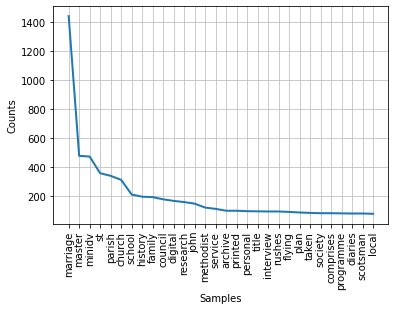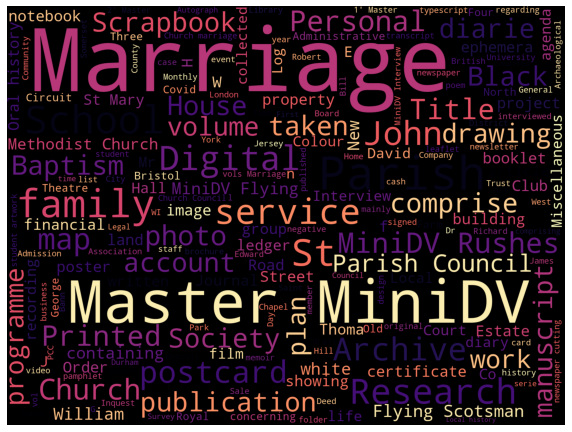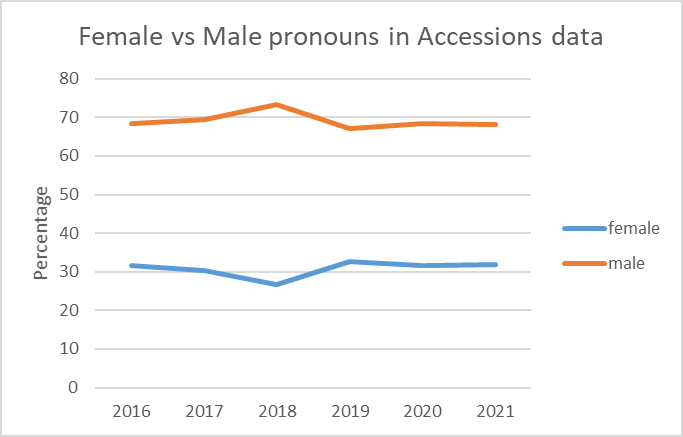Main section
Image above: Queer/Disrupt, University of Warwick research group: artwork
Image credit: Anya Palamartschuk; Warwick University: Modern Records Centre (Ref: QTQ)
Click on the headings below to read our analysis of the 2021 Accessions to Repositories survey data.
Tabs Navigation
Tabs
Keywords
Church, school and council records remain the most common and largest collections accessioned overall. However, 2021 did see a significant increase in the accession of marriage registers, possibly on account of changes in marriage registration. The data also show a surprising volume of ‘master minidv’s’. But it doesn’t mean archives have suddenly become interested in collecting cassettes. This is an anomaly and shows how results of analysis can be skewed by a very large, item listed, accession. In this case a significant number of camcorder tapes accessioned by the National Railway Museum.

word frequency in the Accessions 2021 dataset
‘Digital’ also appears among the top keywords, suggesting that this medium is becoming more important, even if the overall volume of digital accessions remains low. In all, however, the type of records collected, as well as descriptive practice, appears to remain relatively unchanged.

Graphic showing most common words in the 2021 Accessions dataset
Public records
The quantity of public records accessioned has fluctuated quite considerably over the past six years. It dropped significantly in 2020 as a consequence of the pandemic, with 37 repositories collecting 577.86 lm. Last year saw a small increase, with 39 archives accessioning 924.91 linear metres of records eligible for New Burdens funding. This brings it closer to the overall average of 46 PoDs and 1295.8 lm. New Burdens funding aims to help cover costs associated with the 30-year rule for transferring records changing to the 20-year-rule. The funding is due to continue until 2025.
Four repositories collected more than 100 lm of public records including Teesside Archives, West Yorkshire Archive Service, Wakefield, Gloucestershire Archives, and Worcestershire Archive and Archaeology Service. These collections account for just over half of the total quantity of public records accessioned in 2021.
Teesside Archives acquired 137 lm of magistrate court records, the largest overall public record collection for 2021, for which they received £97760.46 of New Burdens funding. Magistrate court records continue to be the largest public record collections accessioned, making up 44% of records eligible for New Burdens funding in 2021. NHS and coroners records accounted for 29% and 27% respectively. The volume of prison records accessioned was negligible, at less than 1% of the total. Records from prisons have consistently been the smallest category of public records accessioned since 2015, with only just over 37 lm accessioned in total.

Public records accessions remain primarily in paper format; there have been no significant collections of digital public records since 2015.
Dataset diversity
The messy nature and type of language used in the accessions dataset makes it challenging to analyse, particularly in terms of finding themes and topics. When it comes to measuring diversity, it is similarly difficult to get an accurate picture. People within the dataset are not always described in terms of race or ethnicity, and the presence of a term does not always mean that is what the records are about. Of the five times terms related to Islam that appear in the 2021 dataset, for instance, two are actually about Christianity and British nationalism in relation to Islam rather than Muslims or Islam itself.
It does seem, moreover, that the stability that comes across in collecting trends is somewhat indicative; there is limited change and that may come at a cost to diversity. In terms of sexuality and gender, for example, keywords related to LGBTQ are relatively few and far between, occurring only between 14 and 35 times each year from 2016 to 2021. And male pronouns continue to be used twice as frequently as female pronouns throughout the dataset.

Graph showing the difference in use of male and female pronouns in the accessions dataset
Digital accessions
There is little discernible pattern in the quantity of digital collections accessioned over the past five years. The volume changes significantly year on year. But it is possible to see the differing effects of the pandemic on different types of archive; local and national institutions collected more digital material during the pandemic, while university and special archives collected considerably less. This changed in 2021 with digital records making up over 7% of collections accessioned by university and special repositories. For local and national archives, digital material accounted for just under 5% of their accessions, down from 6% and 20% respectively in 2020.

Bristol University Information Services Special Collections’ accession of historical photographs of the China Project was the largest digital collection at 5.6TB. This collection makes up just over a third of the 14.8TB of digital records accessioned in 2021. There is an overall trend of a few archives accessioning large digital collections, which make up the bulk of digital material accessioned each year.